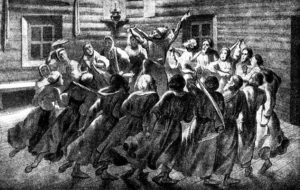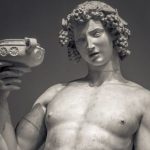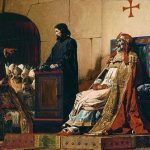 Creepy
Creepy  Creepy
Creepy  Technology
Technology 10 Scientific Breakthroughs of 2025 That’ll Change Everything
 Our World
Our World 10 Ways Icelandic Culture Makes Other Countries Look Boring
 Misconceptions
Misconceptions 10 Common Misconceptions About the Victorian Era
 Mysteries
Mysteries 10 Strange Unexplained Mysteries of 2025
 Miscellaneous
Miscellaneous 10 of History’s Most Bell-Ringing Finishing Moves
 History
History 10 Great Escapes That Ended Right Back in Captivity
 Weird Stuff
Weird Stuff 10 Fascinating Things You Might Not Know About Spiders
 Food
Food 10 Everyday Foods You Didn’t Know Were Invented by the U.S. Military
 History
History 10 Odd Things Colonial Americans Kept at Home
 Creepy
Creepy 10 More Representations of Death from Myth, Legend, and Folktale
 Technology
Technology 10 Scientific Breakthroughs of 2025 That’ll Change Everything
 Our World
Our World 10 Ways Icelandic Culture Makes Other Countries Look Boring
Who's Behind Listverse?

Jamie Frater
Head Editor
Jamie founded Listverse due to an insatiable desire to share fascinating, obscure, and bizarre facts. He has been a guest speaker on numerous national radio and television stations and is a five time published author.
More About Us Misconceptions
Misconceptions 10 Common Misconceptions About the Victorian Era
 Mysteries
Mysteries 10 Strange Unexplained Mysteries of 2025
 Miscellaneous
Miscellaneous 10 of History’s Most Bell-Ringing Finishing Moves
 History
History 10 Great Escapes That Ended Right Back in Captivity
 Weird Stuff
Weird Stuff 10 Fascinating Things You Might Not Know About Spiders
 Food
Food 10 Everyday Foods You Didn’t Know Were Invented by the U.S. Military
 History
History 10 Odd Things Colonial Americans Kept at Home
10 Famous Historic People Who Swore They Were Gods
Self-deification is pretty much exactly what it sounds like: when somebody believes themselves to be a god (or, perhaps, God) and tries to convince other people of it, too. And as it turns out, self-deification is not just for the crazy guy down the street who rants and raves at clouds and passing cars! It’s also for some very notable people who lived long ago!
In this list, we’ll take a look at ten people who swore they were gods. They were political leaders, social stand-outs, and historic big-wigs with such a strong god complex that, well, they were sure they must have been more than mortal. These ten individuals were so good at self-deification, in fact, that they managed to convince followers of it, too. And that’s why they’re on this list! While they may not have actually been gods, their wild and wacky stories live on in history, even long after their (very mortal) bodies have left this earth.
Related: 10 Religious Beliefs That Have Changed with History
10 Naram-Sin
Naram-Sin was a ruler of the Akkadian Empire who reigned from 2254 BC to about 2218 BC. He was the third successor in the kingdom and the grandson of the well-known King Sargon of Akkad. But while Sargon was a strong ruler, Naram-Sin was arguably the strongest. Under his rule, the Akkadian empire reached its maximum growth and influence.
In turn, he used that success to proclaim himself the “God of Akkad” and, alternately, the “King of the Four Quarters.” By self-deifying, he became the first-ever Mesopotamian king to have claimed a god-like status for himself. And considering the point in history in which he did so, Naram-Sin is (as far as historians know) the very first person to ever claim to have been a god walking among us on the earth!
Now, it’s true that he did a lot while he ruled the Akkadians. He defeated various other rulers, city-states, and outlying tribes all across the Mediterranean area in his three decades of rule. He oversaw incredible and (literally) groundbreaking construction work on cities including Akkad, Nippur, and Zabala. He built massive administrative centers at Nineveh and Nagar, the likes of which had never been seen before in human civilization.
Politically, his reign was important, too, because he exerted control over every corner of the empire in a direct way that his father, King Sargon, and his other forebears hadn’t done. Also, he appointed many of his own sons to be provincial governors and sent out many of his daughters to be regional high priestesses.
All that is pretty impressive, no doubt. In that way, Naram-Sin certainly pushed forth the progress of civilization with his three decades of powerful and impactful rule over the early Mediterranean. But that’s not what we care about here; our focus is on his self-deification.
If we could go back in time and hear him tell it, he’d explain with a straight face that he was a god. Other Akkadian rulers who followed him liked the idea of holding that power over their subjects so much that they, too, got in on the self-deification action. Talk about starting a trend![1]
9 Jesus Christ
Bet you didn’t expect to see this name on this list, did you? Interestingly, there has long been an active debate among historical scholars and biblical experts about whether Jesus considered himself to be God. And while the debate has most recently begun to err on the claim that no, in fact, he did not, the whole story is a little bit more complicated.
As we all no doubt know, Jesus’ claim was that he was the Son of God brought to earth, martyred, and then resurrected to save us all from our mortal sins and all the rest. But if you read more closely through some (actually, many) passages in the Bible, the question about Jesus’ possible self-deification becomes a bit murkier.
Take John 8:58, for example, in which Jesus says, “Before Abraham was made, I am.” Well, Abraham lived 1,800 years before Jesus did, so would that make Jesus immortal (and thus, god-like, if not God himself)? He again uses that powerful “I am” in Exodus 3:13-14 to claim the name of God for himself, too.
In Mark 14:62, Jesus is at it again, too! He notes, ” I am. And you shall see the Son of man sitting on the right hand of the power of God, and coming with the clouds of heaven.” In John 10:30, he does it again: “I and the Father are one.” And in John 14:9, he wades into those waters yet another time: “Philip, he that seeth me seeth the Father.”
Pretty interesting, right? And then there’s this. During the First Council of Nicaea, in AD 325—about three centuries after Jesus lived and died—the Nicene Creed very explicitly included the notion that Jesus Christ was God incarnate. That’s a pretty big step! (Although not a self-deification, technically, as it came about by others long after Jesus’ body left the mortal realm.)
Other early Christian denominations very steadfastly believed that Jesus was God, too. The Ebionites were a well-known Jewish Christian sect that surged into popularity in the first couple of centuries after Jesus’ death. One of their biggest beliefs was that Jesus had been a divine being.[2]
8 Simon Magus
Simon Magus was one of the first historical figures to clash with a biblical person—in his case, Peter the Apostle. Also known as Simon the Sorcerer and/or Simon the Magician, Simon lived in the biblical era and was very rich. As such, he tried to buy his way into a position as one of the apostles.
His attempt at buying religious influence and (theoretically) gaining eternal favor from Jesus Christ and those around him was thwarted by Peter in their clash, which is recorded in the Acts of the Apostles. Furthermore, Simon Magus’ acts were so blatant and infamous at the time that they coined a word we still use today: simony. That act basically means the motivation to pay for a certain position, title, job, or designation that is unearned or unwarranted otherwise.
In his life, Simon was a Samaritan and a 1st-century AD early convert to Christianity. Before he clashed with Peter, he was baptized by Philip the Evangelist. At some point, though, Simon began getting quite a big head about his place in the religious order.
While Christianity was on the rise, Simon was a very, very minor player. But he didn’t see it that way. In fact, he thought he was a god—and that he ought to be worshiped as such! So, he (and many of his followers who were smooth-talked by his way with words and convincing qualities) descended into a hero worship-style cult of Simonianism.
The writer and religious scholar Irenaeus completely dressed him down, though. In his book Against Heresies, the ancient scholar slammed Simon by noting: “He was glorified by many as if he were a god; and he taught that it was himself who appeared among the Jews as the Son, but descended in Samaria as the Father while he came to other nations in the character of the Holy Spirit. He represented himself, in a word, as being the loftiest of all powers, that is, the Being who is the Father over all, and he allowed himself to be called by whatsoever title men were pleased to address him.” That, as the kids today would call it, is shade![3]
7 Veleda
Veleda was a young woman who lived a brief life in the 1st century AD in what is now modern-day Germany. She was a member of the Bructeri people—a group that found some success during the Batavian Rebellion of AD 69-70. In that rebellion and in the years around it, the Bructeri were able to more or less successfully fight off the Roman legions that were swarming around them.
In a bit of an underdog story, the Bructeri were able to hold most of their land and property and their influence over the Romanized Batavian chieftain at the time, Gaius Julius Civilis. And the whole group had Veleda to thank for it. That’s because, according to legend, she was a seer who could predict the outcomes of battles with great precision. And since her predictions always seemed to be right, she was seen as a deity and a living god-woman for those who resided in her little corner of the world.
Considering when she lived and how relatively primitive the Germanic tribes were at that time, not a ton is known about Veleda today. We do know that she lived in a tower in a small town near the Lippe River, a tributary of the mighty Rhine. A nearby Roman settlement known as Colonia Claudia Ara Agrippinensium (now more or less the modern city of Cologne) accepted her arbitration during a battle they were having with the Tencteri.
The Tencteri were a Germanic tribe that had not been conquered by Roman legions or Rome’s influence. And when Veleda sat to mediate the end of the fighting between those two groups, she proclaimed to see Germanic victory and Roman defeat in the region.
As such, she became very, very popular with many of the tribes and peoples in central Germany. And really, why wouldn’t she? She predicted victory for the locals, who had mostly hoped to cast away the scourge of Rome’s spread. She really played up the god-like aspects of her prognostications and interpretations, too.
Envoys hoping to glean wisdom from Veleda were not allowed to see her in person. Instead, an interpreter went up to the tower and then relayed her messages down to the subjects below. So, was she a god? Or just a woman on a power trip with a god complex? At this point, fully two thousand years after her life and death, that may be a distinction without a difference.[4]
6 Danilo Filippov

In 1645, a runaway Russian soldier named Danilo Filippov (also sometimes called Daniil Filippovich or Danila Filipich, depending on the source and translation) absconded from his duties as a fighting man and founded a religious sect. The sect became known as the Khlysts, and they were surprisingly influential in a very specific way in Russia for a short time.
As for Filippov himself, legend has it that he was a very charismatic man. Sick of the soldier’s life, he claimed that he was a “living god” who had been tasked with saving humanity after the so-called Lord of Hosts had descended down from the heavens to meet with him on a hill in Vladimir Oblast, just a few miles to the east of Moscow.
In decreeing his supposed power over humanity, Filippov forbade a few things, including sexual intercourse, drinking, and even swearing. Which is bull s**t! Jokes aside, Filippov deemed one of his followers to be the “new Christ,” too and then acquired twelve apostles of his own with other adherents. Even a woman believed in Filippov’s schemes so much that she became the “Mother of God.”
The follower who became the “new Christ” was a man named Suslov, by the way. And longtime legend has it that Russian authorities crucified him not once but twice—and he lived both times. While that is (almost certainly?) not true, it speaks to the mystical hold that Filippov and his followers had over a small but vocal group of people.
While historians today debate how influential Filippov was or wasn’t—and some even doubt whether he even existed—there is no question that the Khlyst religious movement was a thing in the late 17th and very early 18th centuries in Russia. Many of the so-called Old Believers of the Russian State Church saw the new-wave Khlysts as heretics and false prophets. As such, the Old Believers documented the Khlysts’ activities meticulously, which is why we now know a bit more about them today.
Filippov’s followers and descendants were smart, too. They very shrewdly kept donating money to the Russian State Church. That allowed them to get away with whatever they wanted as long as the gravy train kept flowing. Whether or not Filippov was actually God, the worshippers coming along behind him certainly knew where their bread was buttered![5]
5 Kondratiy Ivanovich Selivanov
The Skoptsy movement emerged in Russia in the 1760s as something of a complicated and very bizarre follow-up to Filippov’s Khlysts. Basically, the Skoptsy followers were a flagellant sect of the Khlysts. They believed, among other things, in the coerced castration of humans on earth.
Their founder was a very bizarre and controversial man named Kondratiy Ivanovich Selivanov, who believed himself to be God. In turn, the followers who rushed to Selivanov’s side and hung on his every word proclaimed that he was, in fact, a deity with immortal life and incredible powers.
Selivanov was born a lowly peasant, and he’d run away from his life at some point in his early years. In the late 1760s, he started his castration-focused off-shoot sect of the Khlysts’ movement in the village of Sosnovka, near Marshansk. He alternately called himself God and the Son of God, eventually getting nearly 250 people to do the same.
By 1772, he was on trial for it, though. And later that year, he was convicted of persuading 13 peasants to castrate themselves. At first, after the conviction, he escaped from prison—his followers happily noted this was because of his immortality. Thus, he couldn’t be held behind walls. But by 1775, he was re-captured and exiled in far-off Siberia.
Over the next two decades, his followers mobilized their families and friends to locate and free Selivanov. They eventually found him living in Irkutsk. In 1795, he managed to abscond back to Moscow. By 1797, he was living in Saint Petersburg and again claiming to be God while building a roster of followers. But later that year, Tsar Paul I had him confined to a mental hospital.
For the next five years, he lived in incarceration there. Then, in 1802, he was released, and for the next 18 years, he lived in the house of one of his disciples in Saint Petersburg. By then, he identified himself alternately as God, Jesus Christ, and Tsar Peter III. Technically, he claimed for himself the title of “God of Gods and King of Kings.” Then, once again, he demanded his believers find salvation through castration.
Amazingly, Selivanov’s rantings and ravings proved popular. They were so popular, in fact, that the Governor General of Saint Petersburg’s two nephews were among the so-called God’s followers. That rightfully horrified the Governor General, and he ordered Selivanov to be arrested once again in June 1820. From there, he was confined to life in a monastery in Suzdal, northeast of Moscow, until he died in 1832.
That ended up being not so bad for Selivanov. Even though he was not allowed to leave the monastery in those final twelve years of his life, the Governor General did grant him visitors, and his followers routinely made pilgrimages to see him before he passed.[6]
4 Hong Xiuquan
Born in the early 19th century, Hong Xiquan very briefly and radically altered Chinese history through his belief in himself as God. After failing his way through school, Hong was disgruntled at his future prospects in the job market in China under the rule of the Qing Dynasty.
As a result, he did what any disgruntled worker might do: He declared himself the “Heavenly King” and started a religious sect. OK, most disgruntled workers don’t do that. But Hong had big goals! He thought he was alternately God himself or perhaps Jesus Christ’s brother, but either way, he somehow managed to amass a large group of followers.
According to Hong himself, after his school failure, God came to him and directed him to personally rid the world of demons and demon worship. He deduced that getting rid of the Qing Dynasty would be the best and most efficient way to do this. So he rejected China’s popular Confucianism, embraced a very messed-up form of Christianity, and set his followers upon the Qing rulers.
An associate of his then founded the God Worshiping Society, which was meant to fervently spread Hong’s message—and actively worship Hong as an immortal on earth. By 1850, against all common sense and likely odds, Hong counted more than 10,000 followers as part of the God Worshiping Society. And as you might expect, the Qing leaders were starting to get a bit nervous.
Hong had big goals with his newfound fame and influence. In January 1851, he organized his worshipers and followers into a rebel army. Then, he set upon the city of Jintian. That marked the beginning of the bloody and influential Taiping Rebellion. Hong’s followers captured Jintian, and then, a little more than two years later, they captured the city of Nanjing.
Hong declared himself the Heavenly King of the Heavenly Kingdom of Peace. When he had Nanjing in his clutches, he called it the Heavenly Capital of the Kingdom. It was all going according to plan for this supposed god-like brother of Jesus Christ.
Reigning over a whole nation is hard to do, though. Even after he was able to overthrow the Qing Dynasty fully, Hong struggled to maintain his influence. Just a few short years after he stormed Nanjing, he started killing off his advisors and fellow leaders with whom he was concerned about conspiratorial plotting.
By 1864, Hong’s supposed Heavenly Kingdom had lost much influence and ground. In June of that year, amid a major Qing advance back into power, Hong died after a period of illness. His son succeeded as the movement’s leader, but the Qing regained power just a month later. And that was that![7]
3 Dios Buhawi
Ponciano Elofre was a leader of a local government municipality in the Philippines in the 19th century when he led a politico-religious revolt against the colonizing Spanish government that oversaw the islands. In turn, Elofre transitioned his revolt into a full-on religious movement and came to refer to himself as Dios Buhawi—which means “Tornado and/or Whirlwind God” in the local Hiligaynon language.
While Elofre (er, Dios Buhawi) died in 1887, and his movement was mostly forgotten shortly after, he represented one very stark example of how a motivated person can turn personal adversity into a larger push. Elfore’s just so happened to include God!
It all started in the 1880s when Elofre failed to collect taxes that the Spaniards wanted from the locals in his region of Zamboanguita in Negros Oriental, Philippines. Since Ponciano himself was responsible for being the head of the local government, it was on him to collect payment and hand it off to the Spanish colonizers.
When he didn’t do that, Spanish soldiers beat his father, Cris Elofre, to death. They hoped it would teach Ponciano a lesson in following orders from the higher-ups. But what it really did was radicalize him greatly—and get him to push back even harder against Spanish authority.
Immediately, he started preaching against the forced payment of taxes. He also included religious freedom as part of his newfound revolutionary agenda. Specifically, he called for the following of ancient rites of the “babaylan,” who had been an old religious Visayan shaman leader who was influential before the Spanish colonized the Philippines. Soon, his followers came to be known as the “babaylanes.”
In time, he amassed about 2,000 adherents who backed him at every turn. From then on, he became known only as Dios Buhawi. He claimed to have divine knowledge and power, and the locals loved him for it. Interestingly, he began dressing in female clothing and made his mannerisms effeminate. That was supposedly how the ancient “asog” shamans of the area behaved, and Buhawi wanted to match their energy and habits.
The Spanish didn’t care for any of this behavior, though. The Governor General at the time, Valeriano Weyler, sent 500 soldiers and a battleship to deal with Buhawi and his insurgency. On August 22, 1887, Buhawi raided the town of Zamboanguita and put his revolutionary hopes and dreams into action. He was no match for the powerful Spanish forces, though.
In an encounter early in the battle with the European-backed soldiers, Buhawi was killed. So much for his divine status, as it turned out. For a while afterward, his wife, Flaviana Tubigan, tried to continue the revolt. Sadly, she lacked the charisma and presence of her husband. Soon enough, the “babaylanes” turned to mostly banditry, and the religious movement petered out.[8]
2 Father Divine
Father Divine was a Black spiritual leader in the United States throughout the first half of the 20th century. His full self-given name was Reverend Major Jealous Divine, though pretty much everybody knew him as Father Divine. He also liked to refer to himself as “the Messenger” because he thought he was God, and he wasn’t shy about telling others that supposed fact.
While it appears that he was born on a plantation in Georgia in 1876, pretty much nothing is known about Father Divine’s early life. Hilariously, when he was once asked about his childhood and upbringing, he told the interviewer that “the history of God would not be useful in mortal terms.” That’s an amazing answer—and one that mostly shut down speculation into his past among followers and believers.
Beginning in about 1907, Father Divine popped up in the evangelical scene. He went around to Black churches in various places in New York and other cities up and down the Eastern Seaboard. He preached what he called the “Peace Mission.”
His teachings were so popular, positive, and accessible to all that he didn’t just appeal to Black families trying to get out from under Jim Crow in the decades after slavery. Soon, Father Divine had followers of all races, and he loudly preached economic independence, racial equality, and social harmony.
As far as his self-deification goes, Father Divine taught that he was the Second Coming. He regarded himself as Jesus Christ reborn and alternately as God himself sent back to earth to help his followers. He told believers that he was “God’s light” reincarnated and on a mission to show people how to set up a heavenly existence on earth and take the journey toward eternal life.
In the end, Father Divine’s health faltered in the 1960s, and he died in 1965. His time in the sun had come and gone long before then, and other leaders like Medgar Evers, Bayard Rustin, and Martin Luther King Jr. had taken center stage. Still, while Father Divine may not have actually been God, he was highly influential. Many historians today see his preachings in the early 20th century as a critical precursor to the Civil Rights Movement of the 1960s.[9]
1 Lou de Palingboer

Lou de Palingboer was a Dutch fisherman born just before the turn of the 20th century who became an unlikely leader of a religious movement that nearly swept across the Netherlands. Born under the name Louwrens Voorthuijzen in the city of Breezand in 1898, Lou was raised by a religiously devout father. His upbringing was pretty traditional as far as religion went, though.
As a young adult, he chose to become a fisherman. He got married, too, but then that failed. Following his split from his wife, Lou met a woman named Mien Wiertz during a difficult period of his life. Soon, under her influence, he began to believe that he had been sent by God to save the world from the devil.
So Lou did what anybody in that situation would do: He sold his fishing boat and took up employment as an eel vendor at a market in Amsterdam. There, he became known by the name-slash-title that would stick with him for the rest of his life: Lou de Palingboer, which translates to “Lou the Eel Vendor.”
Eels were a hot commodity in the market, so Lou did well enough economically. But it was his captive audience there at the stall that was the best thing for him. He would preach to his customers about God and religion. He claimed he was “the resurrected body of Jesus Christ.” And against all odds, people believed him!
By the early 1950s, he was holding informal meetings in local cafes with interested people who wanted more than just a bit of preaching at the market. And in 1954, he started holding full-scale meetings and revivals at a local theater house. He captivated his audience as a great storyteller who could weave religion, mysticism, and humor.
By 1957, one particularly rich supporter had purchased a house in the nearby city of Muiden, and Lou moved in there with several of his followers. They lived communally, and all worshiped Lou as a supposed God on earth. By then, most of the rest of the people in the Netherlands who didn’t believe in Lou started to see him and his followers as belonging to a cult.
The Dutch authorities felt similarly, but Lou’s followers weren’t violent or aggressive, so they mostly let it be. Over the next decade, the biggest controversy in Lou’s life was the requirement that he testify at various divorces. Couples would split up after learning one supported Lou, and the other was very much not. He had to take the stand in those divorces and explain his teachings and beliefs.
He absolutely hated all of that. So much so that he eventually moved to the city of Agimont in the neighboring nation of Belgium. That way, he could avoid court summons of any kind trying to call him back to the Netherlands. In the end, Lou died in March 1968. He has since mostly been forgotten, and his followers have almost entirely dissipated.[10]








